Tasty, moist pork wrapped with half-soft, half-crispy dough, Shanghai Sheng Jian Bao (生煎包, pan-fried pork buns), traditionally served as breakfast, make a great party food.
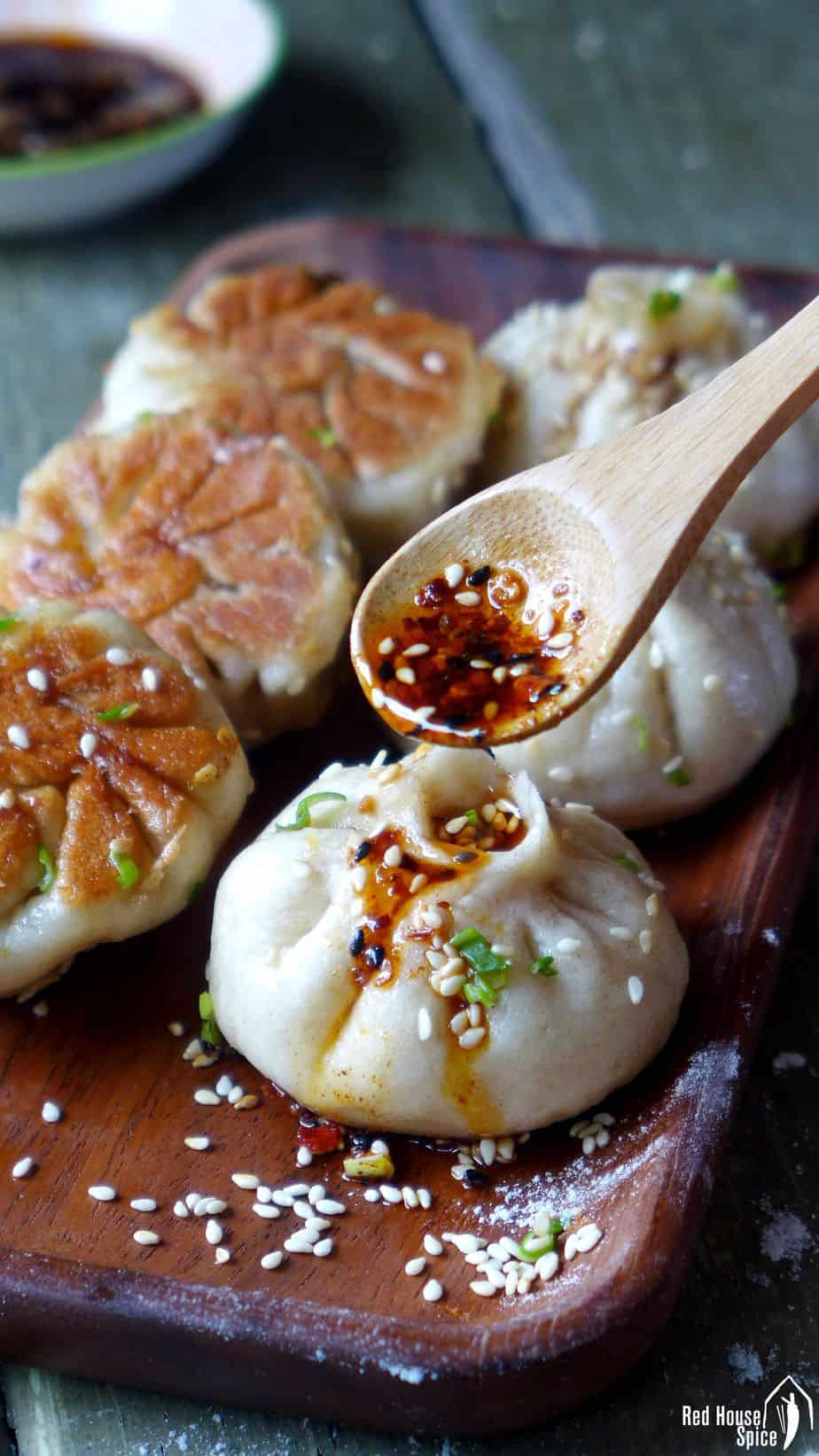
Like many modern cities, Shanghai is full of wonderful choices when it comes to food. I had numerous scrumptious meals during my trips there.
The diversity and creativity of this giant city’s culinary profile was quite impressive. However, the most memorable meal I had there was at a humble, busy breakfast stall which served the local speciality: Sheng Jian Bao/生煎包 (pan-fried pork buns).

Sheng Jian Bao/生煎包 (aka Sheng Jian Mantou/生煎馒头) is a type of Chinese pan fried bao buns. The wrapper is made from yeast dough and the filling contains minced pork, spring onion and various seasonings. It’s quite small in size, similar to a golf ball or even smaller.
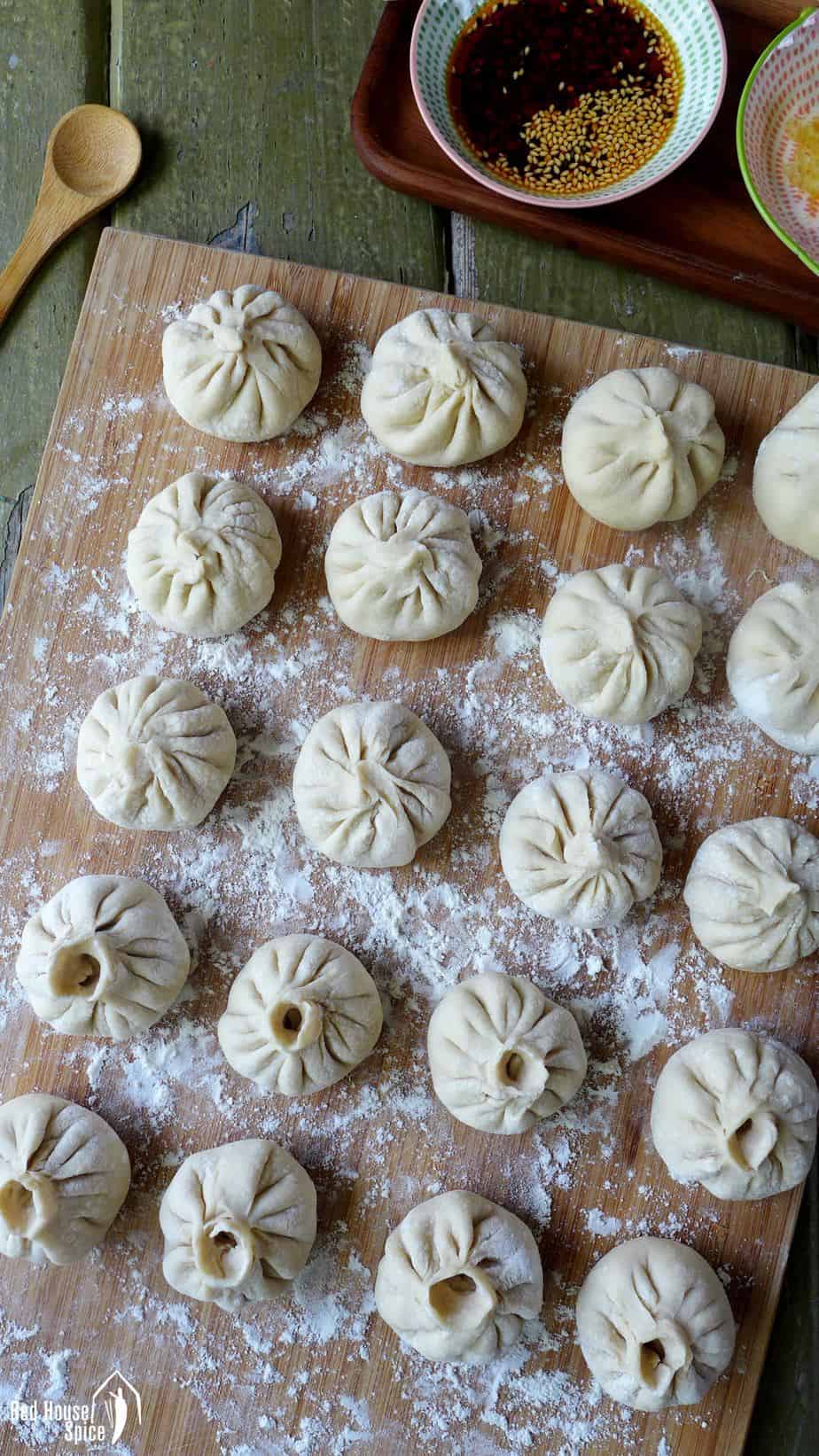
In Shanghai, Sheng Jian Bao/生煎包 (pan-fried pork buns) are traditionally served as breakfast at little cafes and street stalls. They are often cooked in a large pan in front of the queueing customers.
Truly fresh and super tasty, they are simply irresistible! The wrapper has a lovely soft texture with a golden, crispy base . The filling is very flavoursome and moist.
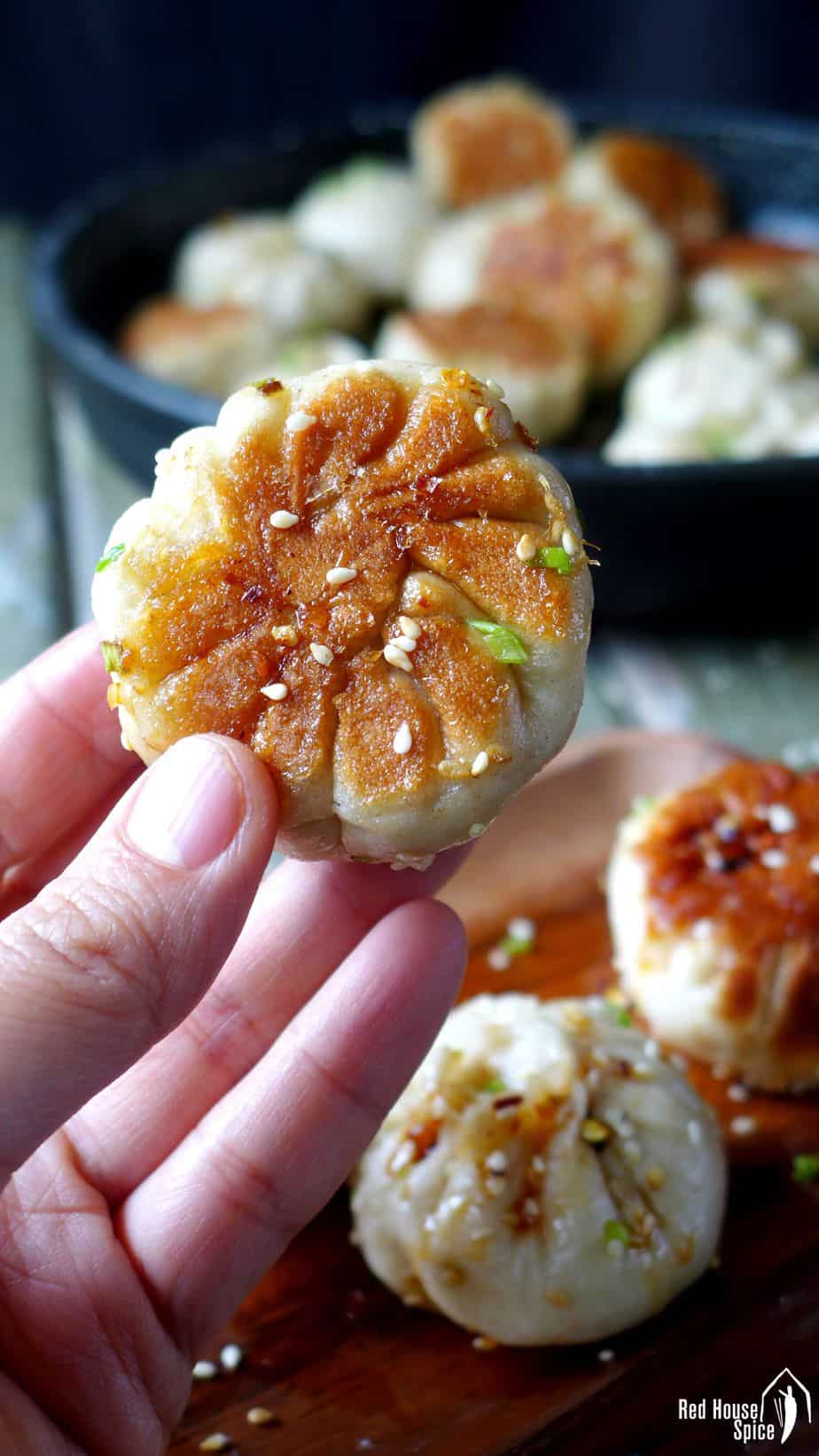
A few years ago, I got a chance to learn the technique of making Sheng Jian Bao/生煎包 (pan-fried pork buns) from a Shanghainese friend. I found it rather simple as it was very similar to how we cook Shui Jian Bao (水煎包, means water-fried buns literally, often vegetarian) in the North-west of China where I grew up. There are five steps to follow:
1. Make the dough. It’s a type of simple yeast dough used in many Chinese dishes, like the one I shared earlier: Spring onion flatbread.

2. Mix the filling. The minced pork is seasoned with spring onion, ginger, light soy sauce, rice wine, Sichuan pepper and sesame oil, etc. In order to make the cooked filling soft and moist, you need to gradually add quite a bit of water (or even better, chicken stock) to the mixture. Stir constantly until no more liquid can be seen.

3. Shape the buns. In this part, you might find it a bit intimidating to seal the buns. It is time consuming if you are not familiar with the folding technique. But I’m sure you’ll soon get the hang of it (please refer to the images above for instructions).
4. Fry the buns. Firstly, crisp the bottom part of the buns in hot oil. Then pour water into the pan and cover with a lid. The steam will help to cook through pretty quickly. A tip: You can either put the folded side facing up or down (As shown in the photos below, I cooked a panful in two ways). Just remember to securely seal the top if you prefer the latter to avoid any juice leaking from the filling.

5. Sprinkle the garnish. I particular like this final touch. Sprinkle finely chopped spring onion and toasted sesame seeds onto the buns at the very last stage of cooking. The remaining steam in the pan helps these sprinkles to stick onto the wrappers. Not only does it looks pretty, it also adds extra flavour to the buns.
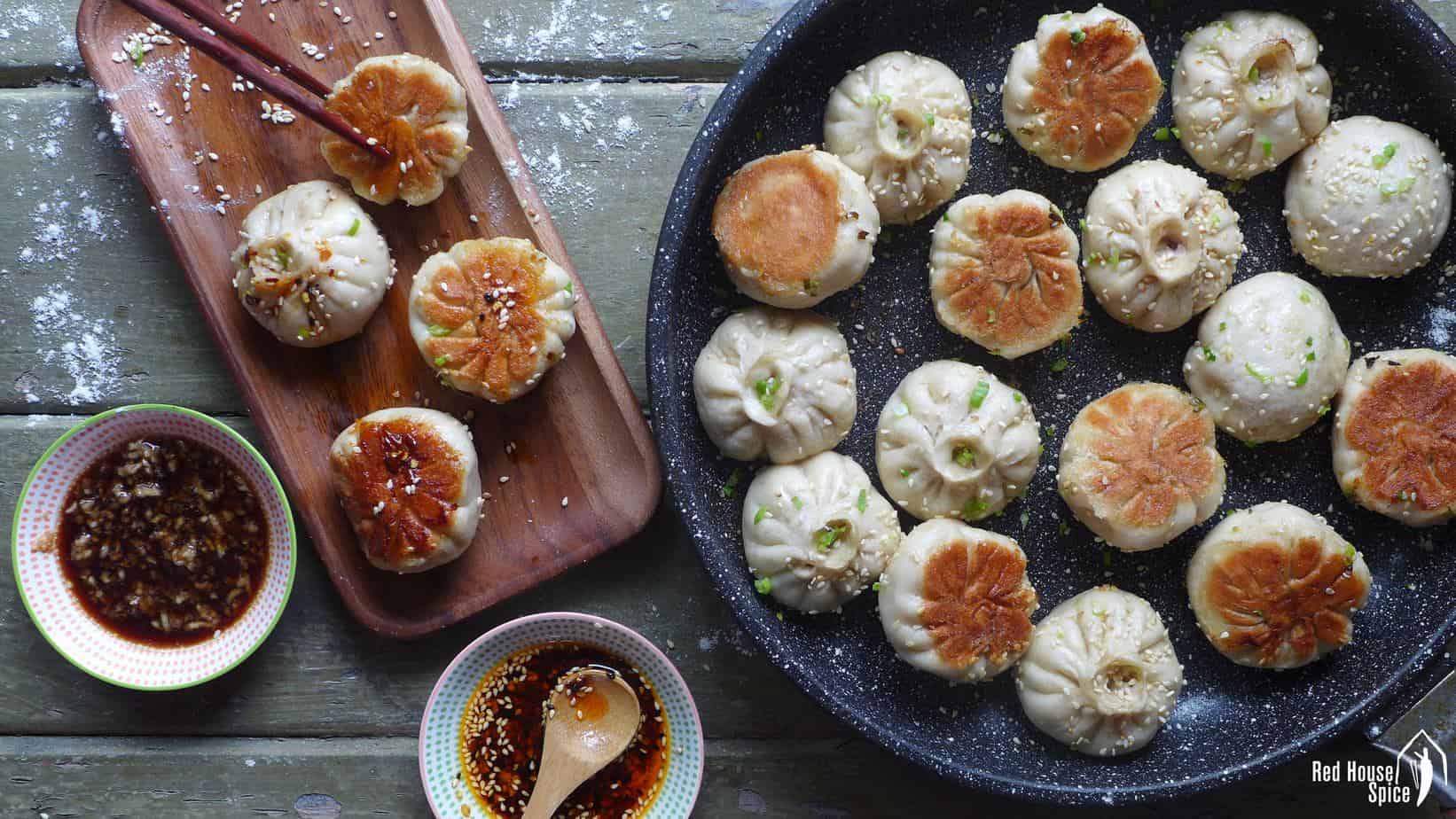
I often make Shanghai Sheng Jian Bao/生煎包 (pan-fried pork buns) for parties. It’s a perfect finger food that’s loved by young and old. If you wish, prepare some dipping sauce on the side. For example, you can use the dressing recipes for dumplings, etc.. Don’t forget to add a dash of homemade chilli oil if you fancy spicing up the buns.
Other bao recipes
Looking for more bao recipes? here are some popular ones to try:
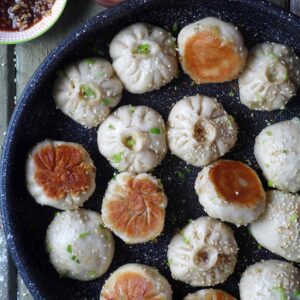
Sheng Jian Bao: Pan-fried pork buns (生煎包)
Ingredients
For the wrappers
- 250 g all-purpose flour - about 2 cups (see note 1)
- 1 teaspoon sugar
- 1 teaspoon dried instant yeast - see note 2
- 140 ml lukewarm water - about 9 tbsp
For the filling
- 250 g minced pork - 9oz
- 2 tablespoon spring onion - finely chopped
- ½ tablespoon ginger - minced
- 2 teaspoon light soy sauce
- ½ teaspoon Shaoxing rice wine
- ½ teaspoon sesame oil
- ¼ teaspoon salt
- 1 pinch ground Sichuan pepper - or Chinese five-spice powder
- 5 tablespoon water - or chicken stock
For frying
- 1 tablespoon cooking oil
- 240 ml water - about 1 cup
For garnishing
- Toasted sesame seeds
- Spring onion - finely chopped
Instructions
Prepare the dough
- In a large bowl, mix flour, yeast and sugar. Pour in water little by little while stirring with a pair of chopsticks (or a fork).
- Then knead with your hand until a smooth, elastic dough forms (see note 3). Cover the bowl with a wet kitchen towel.
- Leave to rise in a warm place until double in size. It will take between 40 minutes to 1.5 hours depending on the room temperature.
Mix the filling
- Put all the ingredients for the filling (except for water/stock) into a large bowl.
- Swirl constantly in the same direction while gradually adding water/stock spoon by spoon into the mixture.
Shape the buns
- Knead the dough on a floured work surface until it goes back to its original size.
- Divide it into 20 equal portions. Roll each piece into a disk-like wrapper.
- Hold the wrapper in the palm of one hand. Place some filling in the middle. Use the other hand to fold the edge anticlockwise by pinching with thumb and index finger until the bun is completely sealed (please refer to the images above).
- Leave to rest for 15 minutes before frying.
Fry the buns
- Heat up oil in a frying pan over a high heat. Place in the buns (see note 4 & 5).
- When the bottom part becomes golden brown, pour in water then cover with a lid.
- Uncover when the water evaporates completely. Sprinkle sesame seeds and spring onion over.
- Cook another 30 seconds or so to crisp up.
NOTES
NUTRITION
NUTRITION DISCLOSURE: Nutritional information on this website is provided as a courtesy to readers. It should be considered estimates. Please use your own brand nutritional values or your preferred nutrition calculator to double check against our estimates.

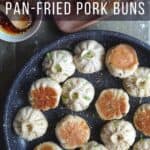
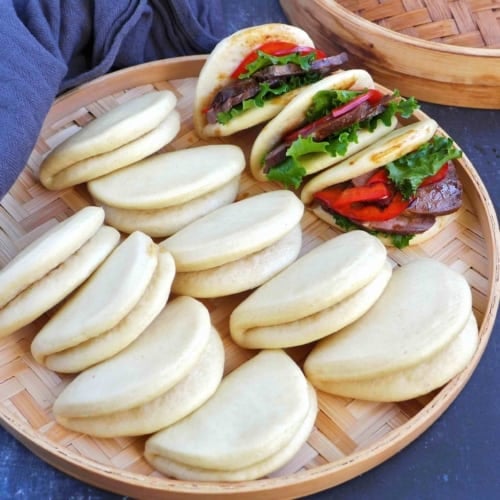
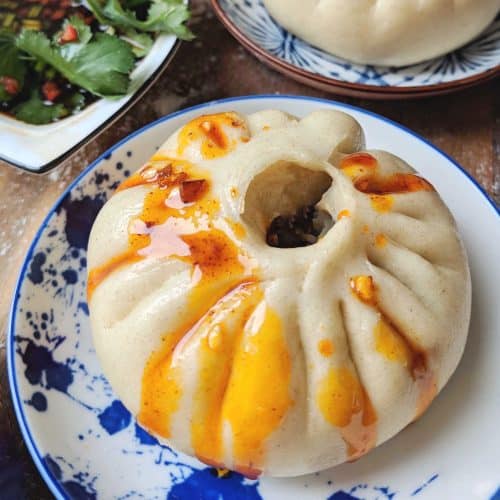
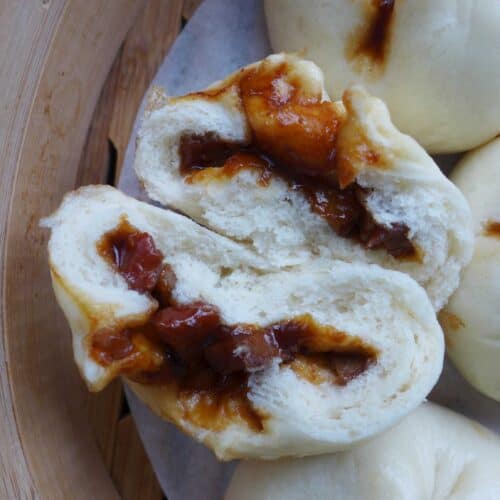
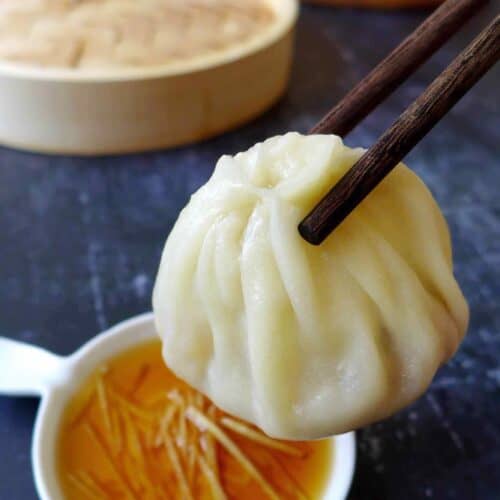
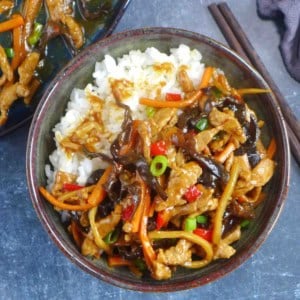
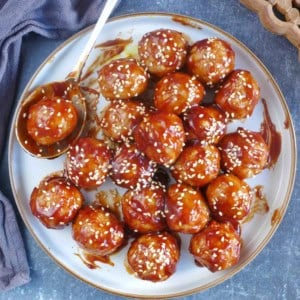
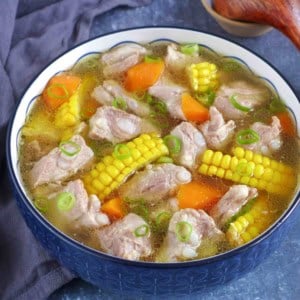
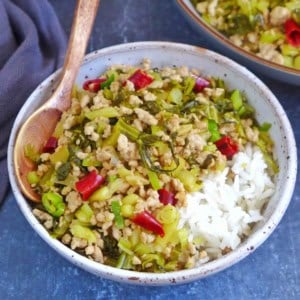
Very good recipe and easy to follow. I made it and taste so yummy! Thanks
So happy to hear that Rita. Thank you for trying out my recipe!
Sorry Kennedy I don’t know it exactly. I suggest you find an online calorie calculator to work out the result.
Hi,
I tried the sheng jian bao in Shanghai and have been trying to replicate it ever since, the only thing is that none of the recipes I have tried manage to get the final dumpling with filled woth enough of that nice juicy soup like the ones in China, I tried adding more stock to the meat and not even then maybe I can try trippñing the anlubt of stock/water I am out of ideas, does your dumpligs end up juicy enough? Not moist but literally beofre eating it do tou have to ipen little holes in it otherwise the hot souo inside could blow up and burn you, that’s the juiciness I need fornmy dumplings, any thoughts? Thanks
Hi! I guess that you might have confused Sheng Jian Bao with Chinese Guan Tang Bao (灌汤包, Soup dumpling) which has lots of liquid inside the wrapper (the same effect as what you described). The latter is steamed instead of being pan fried. Of course, you can make Sheng Jian Bao with juice inside if you wish. The trick is to add some pork rind jelly (肉皮冻) to the filling. Just make sure you remove the pork rind pieces before cooling and chop the jelly into small pieces before adding into the filling.
Hope this is helpful to you. Happy cooking!
That was the key thank you!!!!!, no definitely I was aiming for a juicy sheng jian bao, I tried two places in Shanghai the most famous according to locals in the train station (not the best for me not so juicy) and some little shop near my hotel, those were the best, juicy inside and crunchy fried on the outside, the pork jelly makes all the difference for me, xie xie!
You are more than welcome Fox! You are right. The so-called famous ones are not always great. Instead the humble little cafes often surprise you.
Hi Wei, thanks for sharing the receipt to make such delicious Pan-fried pork buns. Would you please to instruct me how to make the sauce?. Many thanks!
Kim Phuong (from Vietnam)
Hi Kim! Thank you for your interest in my recipes. For the dipping sauce advices, please refer to the last paragraph of the post (right above the recipe box). You will find the links there. Happy cooking!
Hi Joyce, Thank you for popping by! There are many vegetarian versions of filling for Chinese dumplings and buns. Check out the filling for Chinese chive pockets (https://redhousespice.com/chinese-chive-pockets/). Happy cooking!
Thanks Wei! I think I’ll give that a try!
You are welcome Joyce. Hope you like it!
So I’m about two years late on making these, but I finally made them and they did not disappoint! I’ve made several recipes from your blog during lockdown and they have all hit the spot. My only regret with these tasty pork buns is that I couldn’t share them with anyone. Thank you!!
Hi Joyce! Very happy to know my recipes have brought you some happiness during the lockdown. Great food gives us strength and hope which is much needed right now. Stay safe & cook more!
Hi Wei, this recipe looks fantastic. I wonder if you have a vegetarian version? My husband is vegetarian and I would like to try this out so that both of us can enjoy it. Thanks!
Hi Wei, can you make the buns ahead of time before panfrying?
Hi Jennifer! Yes you can make them ahead. After all the buns are assembled and left to rest for 15 minutes (resting is essential), you can lay them on a tray (dust with flour or line with parchment paper) to freeze. Then put them in an air-tight bag when totally frozen. You may pan fry them the normal way (without defrosting). Just increase a little bit the volume of water needed for steaming. Happy cooking!
I made them today! Thank you. They came out delicious! My husband was impressed.
That’s great! My pleasure Jennifer!
Hi Wei, what’s the brand of flour that you use? Thank you! – jenny
Hi Jenny! I normally buy flour from UK’s mainstream supermarkets. Tesco plain flour for example. Have a lovely day!
I tried this recipe tonight and it was really wonderful! I didn’t put in the ingredients that my family normally wouldn’t eat so they like the buns a lot. Thanks for writing such an easy-to-follow recipe, Wei!
Oh! That’s wonderful! You are more than welcome Zhien! Will share more recipes with passionate readers like you.
Hi Wei. I’m attempting to make your Sheng Jian Bao recipe today. I really miss these after eating lots of them in Shanghai the other year!!
Just one quick question, roughly how much water do you add to the pan when steaming? Is it just enough to cover the bottom of the pan?
Thanks Cath
Hi Cath! As shown in the list of ingredients (the group “for frying”), I use 1 cup of water (240ml) to fry 20 buns in a 28cm frying pan. You don’t need to be that precise. But my measurement gives you a good idea of the usage. Hope this helps and happy cooking!!